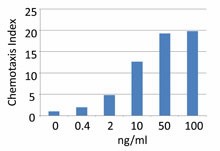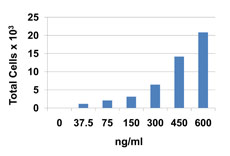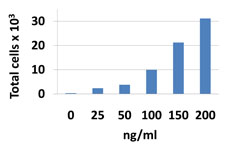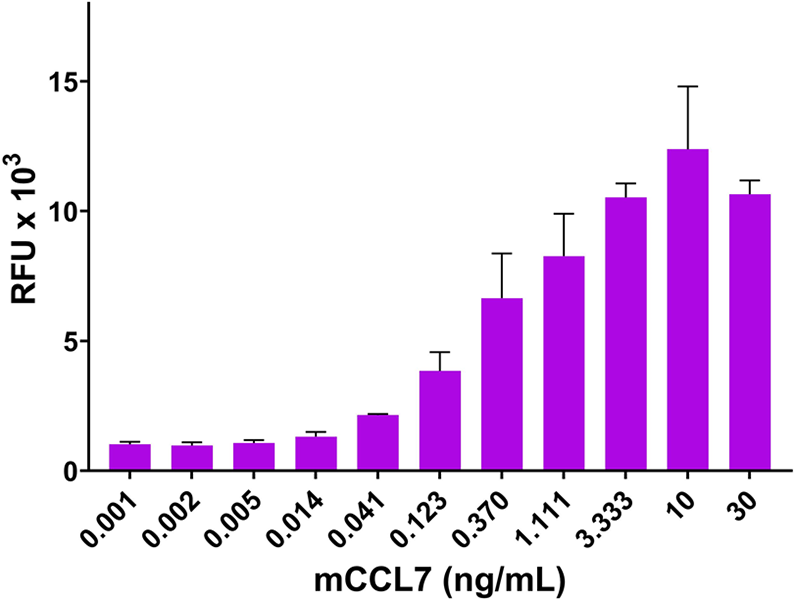- Regulatory Status
- RUO
- Other Names
- Eotaxin, eotaxin-1
- Ave. Rating
- Submit a Review
- Product Citations
- publications

-

Baf3-hCCR3 transfectants chemoattracted by mouse CCL11.
CCL11 is a member of the CC chemokine family and was originally identified as a chemoattractant for eosinophils. In response to allergens, CCL11, which participates in a variety of allergic diseases, promotes accumulation of eosinophils. In addition, CCL11 facilitates proliferation and metastasis of tumor cells expressing the CCL11 receptor, CCR3. CCL11 has been shown to induce angiogenic response by CCR3-positive microvascular endothelial cells.
Product DetailsProduct Details
- Source
- Mouse CCL11, amino acids His24-Pro97 (Accession# NM_011330) was expressed in E. coli.
- Molecular Mass
- The 74 amino acid recombinant protein has a predicted molecular mass of approximately 8.4 kD. The DTT-reduced protein migrates at approximately 12 kD and non-reduced protein migrates at approximately 14 kD by SDS-PAGE. The N-terminal amino acid is Histidine.
- Purity
- >98%, as determined by Coomassie stained SDS-PAGE.
- Formulation
- 0.22 µm filtered protein solution is in PBS.
- Endotoxin Level
- Less than 0.01 ng per µg cytokine as determined by the LAL method.
- Concentration
- 10 and 25 µg sizes are bottled at 200 µg/mL. 100 µg size and larger sizes are lot-specific and bottled at the concentration indicated on the vial. To obtain lot-specific concentration and expiration, please enter the lot number in our Certificate of Analysis online tool.
- Storage & Handling
- Unopened vial can be stored between 2°C and 8°C for up to 2 weeks, at -20°C for up to six months, or at -70°C or colder until the expiration date. For maximum results, quick spin vial prior to opening. The protein can be aliquoted and stored at -20°C or colder. Stock solutions can also be prepared at 50 - 100 µg/mL in appropriate sterile buffer, carrier protein such as 0.2 - 1% BSA or HSA can be added when preparing the stock solution. Aliquots can be stored between 2°C and 8°C for up to one week and stored at -20°C or colder for up to 3 months. Avoid repeated freeze/thaw cycles.
- Activity
- Bioactivity was measured by its property to chemoattract Baf3-hCCR3 transfectants in a dose dependent manner.
- Application
-
Bioassay
- Application Notes
-
BioLegend carrier-free recombinant proteins provided in liquid format are shipped on blue-ice. Our comparison testing data indicates that when handled and stored as recommended, the liquid format has equal or better stability and shelf-life compared to commercially available lyophilized proteins after reconstitution. Our liquid proteins are verified in-house to maintain activity after shipping on blue ice and are backed by our 100% satisfaction guarantee. If you have any concerns, contact us at tech@biolegend.com.
-
Application References
(PubMed link indicates BioLegend citation) -
- Conroy DM, et al. 2001. Respir. Res. 2:150.
- Levina V, et al. 2009. Clin. Cancer Res. 15:2647.
- Salcedo R, et al. 2001. J. Immunol. 166:7571.
- Kaehler J, et al. 2006. J. Investig. Med. 54:446.
- Hadjicharalambous C, et al. 2004. J. Allergy Clin. Immunol. 113:657.
- Crump MP, et al. 1998. J. Biol. Chem. 273:22471.
Antigen Details
- Structure
- Chemokine
- Distribution
-
Epithelial cells, smooth muscle cells, dendritic cells, and fibroblasts
- Function
- CCL11 selectively recruits eosinophils through binding to the chemokine receptor CCR3 during allergic response. CCL11 production is upregulated in response to several proinflammatory cytokines, such as IL-4, IL-13, TNF-α, and IFN-α, produced by mast cells and Th2 lymphocytes. CCL11 has been reported to stimulate eosinophil release from bone marrow, resulting in an elevated level of circulating eosinophils.
- Interaction
- Eosinophils
- Ligand/Receptor
- CCR3
- Cell Type
- Dendritic cells
- Biology Area
- Angiogenesis, Cell Biology, Immunology, Neuroinflammation, Neuroscience
- Molecular Family
- Cytokines/Chemokines
- Gene ID
- 20292 View all products for this Gene ID
- UniProt
- View information about CCL11 on UniProt.org
Related FAQs
- Why choose BioLegend recombinant proteins?
-
• Each lot of product is quality-tested for bioactivity as indicated on the data sheet.
• Greater than 95% Purity or higher, tested on every lot of product.
• 100% Satisfaction Guarantee for quality performance, stability, and consistency.
• Ready-to-use liquid format saves time and reduces challenges associated with reconstitution.
• Bulk and customization available. Contact us.
• Learn more about our Recombinant Proteins. - How does the activity of your recombinant proteins compare to competitors?
-
We quality control each and every lot of recombinant protein. Not only do we check its bioactivity, but we also compare it against other commercially available recombinant proteins. We make sure each recombinant protein’s activity is at least as good as or better than the competition’s. In order to provide you with the best possible product, we ensure that our testing process is rigorous and thorough. If you’re curious and eager to make the switch to BioLegend recombinants, contact your sales representative today!
- What is the specific activity or ED50 of my recombinant protein?
-
The specific activity range of the protein is indicated on the product datasheets. Because the exact activity values on a per unit basis can largely fluctuate depending on a number of factors, including the nature of the assay, cell density, age of cells/passage number, culture media used, and end user technique, the specific activity is best defined as a range and we guarantee the specific activity of all our lots will be within the range indicated on the datasheet. Please note this only applies to recombinants labeled for use in bioassays. ELISA standard recombinant proteins are not recommended for bioassay usage as they are not tested for these applications.
- Have your recombinants been tested for stability?
-
Our testing shows that the recombinant proteins are able to withstand room temperature for a week without losing activity. In addition the recombinant proteins were also found to withstand four cycles of freeze and thaw without losing activity.
- Does specific activity of a recombinant protein vary between lots?
-
Specific activity will vary for each lot and for the type of experiment that is done to validate it, but all passed lots will have activity within the established ED50 range for the product and we guarantee that our products will have lot-to-lot consistency. Please conduct an experiment-specific validation to find the optimal ED50 for your system.
- How do you convert activity as an ED50 in ng/ml to a specific activity in Units/mg?
-
Use formula Specific activity (Units/mg) = 10^6/ ED50 (ng/mL)














Follow Us